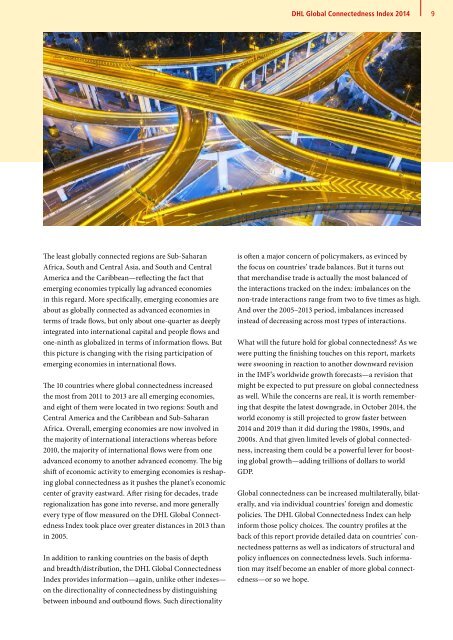DHL Global Connectedness Index 2014
DHL Global Connectedness Index 2014
DHL Global Connectedness Index 2014
- No tags were found...
Create successful ePaper yourself
Turn your PDF publications into a flip-book with our unique Google optimized e-Paper software.
<strong>DHL</strong> <strong>Global</strong> <strong>Connectedness</strong> <strong>Index</strong> <strong>2014</strong><br />
9<br />
The least globally connected regions are Sub-Saharan<br />
Africa, South and Central Asia, and South and Central<br />
America and the Caribbean—reflecting the fact that<br />
emerging economies typically lag advanced economies<br />
in this regard. More specifically, emerging economies are<br />
about as globally connected as advanced economies in<br />
terms of trade flows, but only about one-quarter as deeply<br />
integrated into international capital and people flows and<br />
one-ninth as globalized in terms of information flows. But<br />
this picture is changing with the rising participation of<br />
emerging economies in international flows.<br />
The 10 countries where global connectedness increased<br />
the most from 2011 to 2013 are all emerging economies,<br />
and eight of them were located in two regions: South and<br />
Central America and the Caribbean and Sub-Saharan<br />
Africa. Overall, emerging economies are now involved in<br />
the majority of international interactions whereas before<br />
2010, the majority of international flows were from one<br />
advanced economy to another advanced economy. The big<br />
shift of economic activity to emerging economies is reshaping<br />
global connectedness as it pushes the planet’s economic<br />
center of gravity eastward. After rising for decades, trade<br />
regionalization has gone into reverse, and more generally<br />
every type of flow measured on the <strong>DHL</strong> <strong>Global</strong> <strong>Connectedness</strong><br />
<strong>Index</strong> took place over greater distances in 2013 than<br />
in 2005.<br />
In addition to ranking countries on the basis of depth<br />
and breadth/distribution, the <strong>DHL</strong> <strong>Global</strong> <strong>Connectedness</strong><br />
<strong>Index</strong> provides information—again, unlike other indexes—<br />
on the directionality of connectedness by distinguishing<br />
between inbound and outbound flows. Such directionality<br />
is often a major concern of policymakers, as evinced by<br />
the focus on countries’ trade balances. But it turns out<br />
that merchandise trade is actually the most balanced of<br />
the interactions tracked on the index: imbalances on the<br />
non-trade interactions range from two to five times as high.<br />
And over the 2005–2013 period, imbalances increased<br />
instead of decreasing across most types of interactions.<br />
What will the future hold for global connectedness As we<br />
were putting the finishing touches on this report, markets<br />
were swooning in reaction to another downward revision<br />
in the IMF’s worldwide growth forecasts—a revision that<br />
might be expected to put pressure on global connectedness<br />
as well. While the concerns are real, it is worth remembering<br />
that despite the latest downgrade, in October <strong>2014</strong>, the<br />
world economy is still projected to grow faster between<br />
<strong>2014</strong> and 2019 than it did during the 1980s, 1990s, and<br />
2000s. And that given limited levels of global connectedness,<br />
increasing them could be a powerful lever for boosting<br />
global growth—adding trillions of dollars to world<br />
GDP.<br />
<strong>Global</strong> connectedness can be increased multilaterally, bilaterally,<br />
and via individual countries’ foreign and domestic<br />
policies. The <strong>DHL</strong> <strong>Global</strong> <strong>Connectedness</strong> <strong>Index</strong> can help<br />
inform those policy choices. The country profiles at the<br />
back of this report provide detailed data on countries’ connectedness<br />
patterns as well as indicators of structural and<br />
policy influences on connectedness levels. Such information<br />
may itself become an enabler of more global connectedness—or<br />
so we hope.





